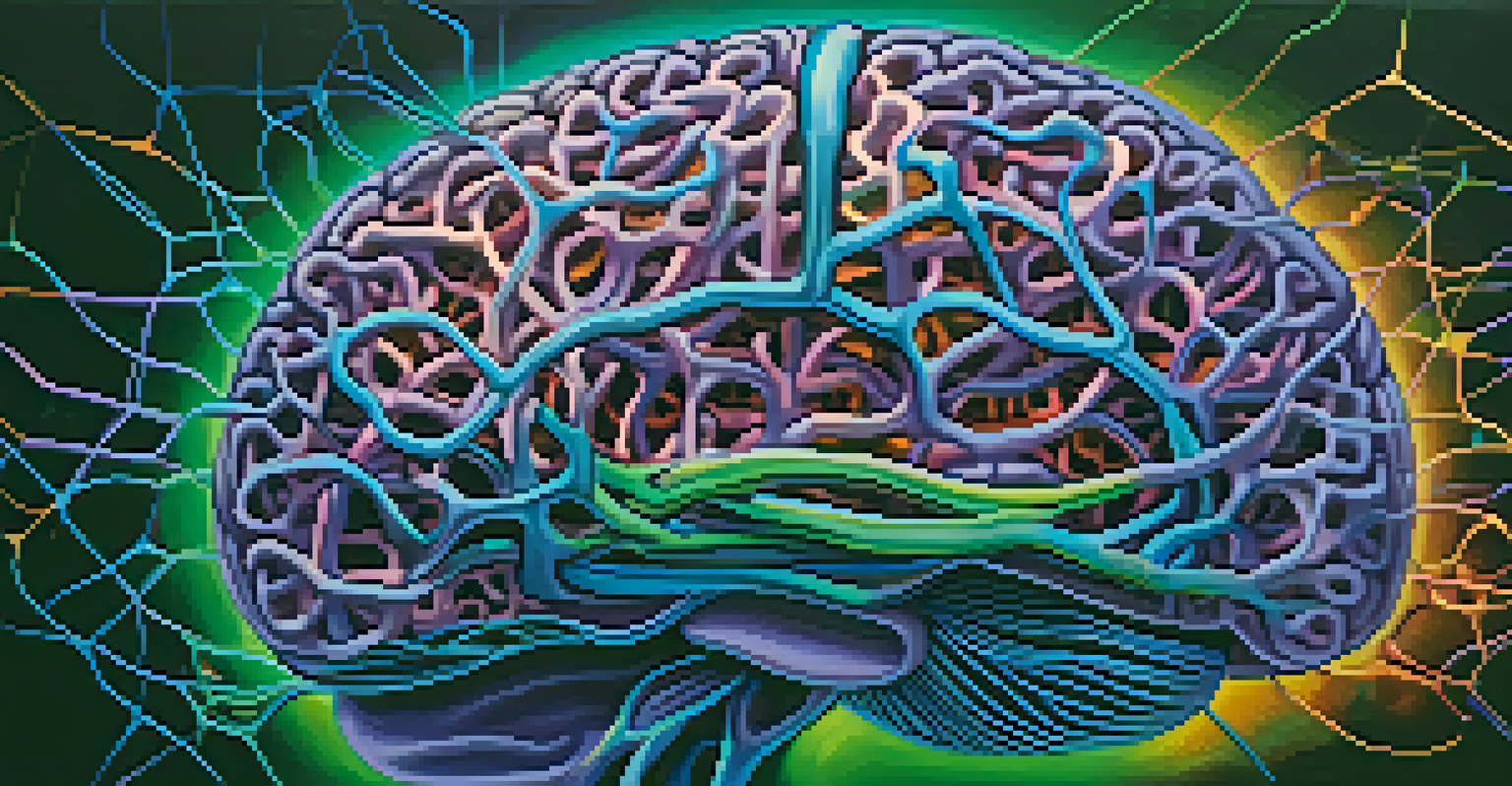Entheogen-Induced States: A Neurological Perspective

Understanding Entheogens: A Brief Overview
Entheogens are substances that induce altered states of consciousness, often used in spiritual or religious contexts. These natural compounds, such as psilocybin and ayahuasca, have been part of human culture for centuries. The term 'entheogen' itself suggests a connection to the divine, as it translates to 'generating the divine within.' By exploring the historical and cultural significance of these substances, we can better appreciate their profound effects on human experience.
The use of entheogens can lead to profound personal insights and a greater sense of connection with the universe.
Many cultures have utilized entheogens for healing, introspection, and connection to a higher power. For instance, Indigenous peoples in the Amazon have used ayahuasca in shamanic rituals to foster spiritual growth and insight. As the modern world begins to recognize the potential therapeutic benefits of these substances, the conversation surrounding their use continues to evolve.
Understanding entheogens requires us to look beyond their recreational use; they have the potential to unlock deep psychological insights and transformative experiences. This exploration is not only fascinating but also crucial for grasping how these substances interact with the brain and influence our perceptions of reality.
The Brain on Entheogens: A Neurological Perspective
When entheogens enter the body, they interact with neurotransmitters in the brain, particularly serotonin. This interaction can lead to a range of effects, from altered perception of time to vivid visual and auditory experiences. The brain regions affected during these experiences include the default mode network (DMN), which is associated with self-referential thoughts and ego dissolution.

Research has shown that entheogens can temporarily disrupt the DMN, leading to a sense of interconnectedness and oneness with the universe. This phenomenon is often described by users as a feeling of unity or enlightenment, highlighting how these substances can challenge conventional notions of self. By studying these neurological changes, we can better understand the potential therapeutic applications of entheogens.
Entheogens and Spiritual Healing
Entheogens have been used for centuries in various cultures for spiritual growth, healing, and introspection.
The neurological perspective offers a scientific lens through which to view the subjective experiences induced by entheogens. By bridging the gap between spirituality and science, we can appreciate how these substances may elevate human consciousness and promote psychological healing.
Therapeutic Potential of Entheogens: What the Research Says
Recent studies indicate that entheogens could play a significant role in treating mental health conditions such as depression, PTSD, and anxiety. For instance, psilocybin has shown promising results in clinical trials, helping patients find relief from symptoms when traditional treatments fall short. This emerging field of research underscores the importance of understanding the neurological effects of these substances.
Entheogens are not just drugs; they are powerful tools that can help us navigate the complexities of our minds and spirits.
The therapeutic approach often involves guided sessions under the supervision of trained professionals, allowing patients to navigate their experiences in a safe environment. This controlled setting can enhance the healing potential of entheogens, providing a supportive space for introspection and emotional release. Participants often report lasting positive changes in their mental health and overall well-being.
While the research is still in its early stages, the results are encouraging. As we continue to uncover the mechanisms behind entheogen-induced states, we may be on the verge of a new paradigm in mental health treatment, one that embraces the intricate relationship between mind, brain, and spirit.
The Role of Neuroplasticity in Entheogen Experiences
Neuroplasticity refers to the brain's ability to reorganize and form new connections throughout life. Entheogens may enhance neuroplasticity, allowing individuals to break free from entrenched thought patterns and behaviors. This is particularly beneficial for those struggling with addiction or trauma, as it opens up new pathways for healing and growth.
Studies have shown that substances like ayahuasca can increase brain-derived neurotrophic factor (BDNF), which promotes the survival of neurons and fosters the formation of new synapses. This biological response can lead to lasting changes in mood and cognition, helping individuals develop healthier coping mechanisms. Essentially, entheogens may facilitate a kind of mental reset, allowing users to approach their lives with fresh perspectives.
Neurological Effects of Entheogens
Entheogens interact with neurotransmitters in the brain, potentially leading to profound changes in perception and consciousness.
The connection between neuroplasticity and entheogens emphasizes the potential for profound transformation. By harnessing the brain's natural adaptability, individuals may experience significant shifts in their emotional landscapes, ultimately leading to improved mental health outcomes.
Cultural and Ethical Considerations in Entheogen Use
As interest in entheogens grows, it's vital to consider the cultural contexts from which these substances originate. Many traditional practices surrounding entheogen use emphasize respect for nature and spiritual connection. It's essential to honor these traditions and acknowledge the cultural heritage that shapes their significance.
Ethical considerations also arise when discussing the commodification of entheogens in modern society. As these substances become more mainstream, the risk of appropriation and exploitation increases. Advocating for responsible use and supporting Indigenous communities can help preserve the integrity of these practices while promoting ethical consumption.
Navigating the cultural and ethical landscape surrounding entheogens requires sensitivity and awareness. By fostering respectful dialogue and collaboration, we can ensure that the exploration of these substances remains grounded in the values of empathy and understanding.
Personal Accounts: Transformative Experiences with Entheogens
Many individuals who have engaged with entheogens report life-changing experiences that reshape their understanding of themselves and the world. These personal accounts often highlight moments of profound insight, emotional healing, and spiritual awakening. By sharing these narratives, we can grasp the deeply personal nature of entheogen-induced states.
For example, some users describe feeling a sense of interconnectedness with others and the universe, leading to increased compassion and empathy. Others report confronting deep-seated fears and traumas, resulting in cathartic release and newfound clarity. These stories illustrate the transformative potential of entheogens, showcasing their ability to foster meaningful change in people's lives.
Therapeutic Potential of Entheogens
Recent studies suggest that entheogens may effectively treat mental health conditions like depression and PTSD.
Personal narratives not only enrich our understanding of entheogen experiences but also emphasize the importance of responsible use. By learning from these stories, we can promote a more informed and compassionate approach to entheogen exploration.
Looking Ahead: The Future of Entheogen Research
The future of entheogen research appears promising, with increasing interest from both the scientific community and the public. As more studies emerge, we can expect to gain deeper insights into the neurological and psychological effects of these substances. This growing body of knowledge may pave the way for innovative therapeutic applications and a broader acceptance of entheogens in mental health care.
Moreover, ongoing research has the potential to destigmatize entheogen use and promote understanding of their benefits. By fostering open dialogue and education, we can help shift societal perceptions and encourage responsible engagement with these substances. This shift could ultimately lead to more effective treatments for various mental health challenges.

As we look ahead, the intersection of neuroscience, psychology, and spirituality will continue to shape the conversation around entheogens. By embracing a holistic perspective, we can harness the potential of these substances to enhance human well-being and enrich our understanding of consciousness.